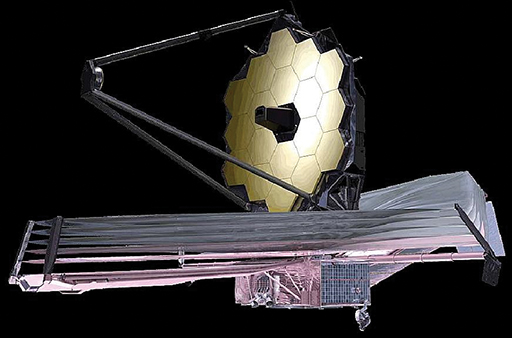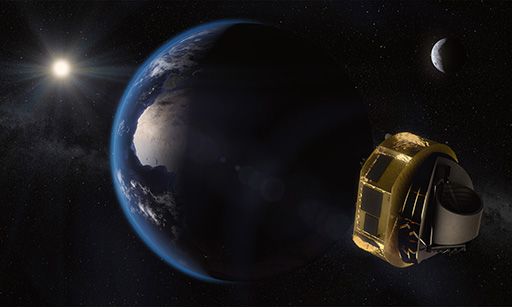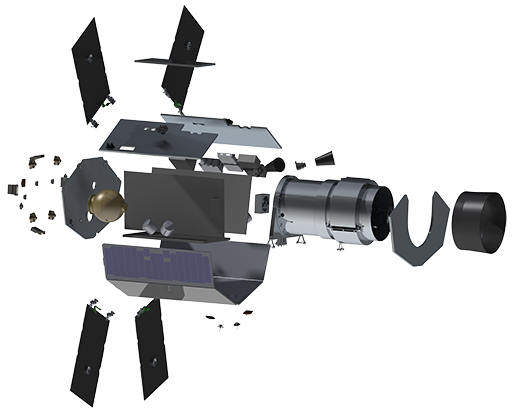5.3 Studying new worlds: JWST, Twinkle and ARIEL
Of course, the ultimate goal is to be able to find out what all of these planets are like. In Week 7 you learned about transmission spectroscopy and how we’ve been able to learn about the atmospheres of some transiting planets. Over the next few years, the opportunity to do this sort of work will increase with the launch of the new international observatory called the James Webb Space Telescope (JWST). There are also two proposed spacecraft that would be dedicated to transmission spectroscopy that may also be launched within the next decade.
The James Webb Space Telescope
The eagerly awaited 2018 launch of JWST has unfortunately had to be delayed and is currently scheduled for March 2021. Seen on some level as the successor to the successful Hubble Space Telescope, it will actually be capable of very different science. JWST’s 6.5 metre gold-coated mirror is nearly three times the diameter of Hubble’s, making it a much more sensitive telescope, but the key difference is that JWST will observe almost exclusively in the infrared. This makes it especially suitable for spotting gases in planetary atmospheres.

JWST has an ambitious design. On launch, it will travel to a region of space on the other side of the Earth from the Sun. This means JWST will orbit the Sun in Earth’s shadow, which will keep JWST cool. Because warm things emit infrared radiation, as you learned in Week 7, infrared telescopes need to be kept very cold so they don’t interfere with their own measurements. The telescope has to be folded up small for launch, so when it gets to its new home it will have to unfold itself over a period of several days.
The following video is fairly long, but it shows just how complicated space telescopes like JWST can be. It will take JWST 15 days to fully unfold. Its large composite mirror has to fold, and importantly its heat shield – the bit that looks like layers of tin foil – has to deploy to make sure the spacecraft can maintain a cool enough temperature.
JWST will be able to obtain transmission spectra of exoplanets spanning a wide chunk of the infrared region. Importantly, because of its large mirror and impressive sensitivity, it even has the potential to do this for small planets like those in the TRAPPIST-1 system. By observing these planets several times over, it could detect the presence of the biosignature gas ozone if it’s present in large enough quantities like the Earth’s atmosphere. JWST could therefore provide us with our first hint of another inhabited world.
Activity _unit9.5.6 Activity 7 JWST
Name two things that help JWST to keep itself cool enough to make measurements.
Answer
JWST orbits the Sun, but it will permanently remain in Earth’s shadow, which helps to keep it cooler. The heat shield also helps the spacecraft to stay at an appropriate temperature.
Twinkle: off-the-shelf science in the UK
The Twinkle Mission is on a very different scale to JWST. It is being developed on a small budget in the UK with the aim of launching in 2022, and unlike most specialist space telescopes it will make use of technology that is already available. It will be a small telescope, about a quarter of the diameter of the Hubble Space Telescope, in orbit around the Earth, and it will be able to look at transiting exoplanets using both visible and infrared light.
It may seem like a minnow next to the shark that is JWST, but Twinkle has one very big advantage for exoplanet scientists. JWST is a multi-purpose telescope and it will certainly not be devoting all, or even most, of its time to looking at exoplanets. There are lots of other branches of astronomy eager to make use of it. A small telescope like Twinkle, on the other hand, would be dedicated to transmission spectroscopy of exoplanets.
Having a dedicated telescope increases the number of exoplanets that can be studied. Why is this important?
At some point, you’ve probably met and interacted with a dog – maybe a Labrador or a Golden Retriever. You probably wouldn’t want either of those dogs sitting on your lap, nor would you be likely to carry one in a handbag, but you would perhaps feel fine doing so for a small terrier or a chihuahua. If you want to own, or just play with, a particular dog it’s obviously a good idea to get to know the individual, but it helps to know about the typical behaviour of the breed to put the dog’s personality in context.
Exoplanets, in this respect, are not that different to dogs. At the moment, we’ve studied a few individuals of various types, but what we don’t know is whether or not the things we’re seeing are typical of the type. We also don’t really know exactly where the boundaries lie between different ‘breeds’ of exoplanet. A mission like Twinkle would help us to learn these things.
Another advantage is the potential to conduct repeated observations of planets many times over the lifetime of the mission to see changes in their atmospheres and cloud cover. This could tell us what the weather is like on these distant worlds!
ARIEL: The Atmospheric Remote-Sensing Infrared Exoplanet Large-survey
The latest in our series of transmission spectroscopy missions is ARIEL. It is an exciting time for the ARIEL team, a consortium of more than 50 institutes from 12 European countries: the mission was recently selected by the European Space Agency (ESA) to launch in 2028 against competition from two other candidate space missions.
ARIEL is also a visible-to-infrared small space telescope, about half the diameter of the Hubble Space Telescope. Unlike Twinkle, which will orbit the Earth, ARIEL will be following JWST into Earth’s shadow.
ARIEL is designed to look at up to a thousand transiting exoplanets during a four-year mission, and so will provide a large-scale survey of the chemistry of exoplanet atmospheres. Like Twinkle, it will help us to put previous discoveries in context, helping to build a broader picture of different types of exoplanets and how planetary systems form. Since it won’t be launched until 2028 it will have the opportunity to carry on from missions like JWST, and follow up on targets from PLATO.

Activity _unit9.5.7 Activity 8 Twinkle and ARIEL missions
Even though they are smaller telescopes than JWST, Twinkle and ARIEL can contribute major advances in our knowledge of exoplanets. What is special about missions like Twinkle and ARIEL?
Answer
Twinkle and ARIEL are purpose-built survey spacecraft, so they will study a lot of exoplanets, whereas multi-purpose observatory JWST will only study a few objects. Twinkle and ARIEL provide crucial context for exoplanet observations.
The problem with transmission spectroscopy and related methods is that they rely on the fortuitous alignment of planet and star. So, only a small fraction of exoplanets can be characterised in this way.

